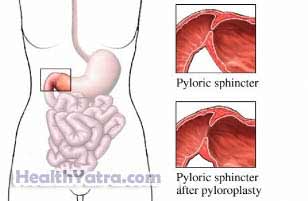Definition
Pyloroplasty is a surgery to correct a narrowing of the pyloric sphincter. The pylorus is a muscular area that forms a channel between the stomach and intestine. Normally, food passes easily from the stomach into the intestine through this sphincter.

Reasons for Procedure
The pylorus sphincter can become narrowed. The condition is called pyloric stenosis. It can cause severe symptoms such as nausea, vomiting, and dehydration. Narrowing of the pylorus can be caused by scarring from ulcers. It can also be caused by a mass, such as cancer.
Pyloric stenosis is a serious condition. Pyloroplasty is often necessary to treat it.
Possible Complications
Complications are rare, but no procedure is completely free of risk. If you are planning to have pyloroplasty, your doctor will review a list of possible complications, which may include:
- Bleeding
- Infection
- Damage to intestines
- Hernia formation at the incision site
- Chronic diarrhea
Factors that may increase the risk of complications include:
- Smoking
- Bleeding disorder
- Advanced age
- Prior surgeries in the abdomen
- Obesity, malnutrition, or dehydration
- Cardiac or respiratory disease
What to Expect
Prior to Procedure
- Do not eat or drink anything after midnight.
- Your doctor may order a laxative. This will help you clean out your intestines.
- If you have diabetes, discuss your medicines with your doctor.
- Talk to your doctor about your medicines. You may be asked to stop taking some medicines up to one week before the procedure, like:
- Aspirin or other anti-inflammatory drugs
- Blood thinners, such as warfarin (Coumadin)
- Clopidogrel (Plavix)
Anesthesia
Your surgery will be done using general anesthesia. You will be in a deep sleep.
Description of Procedure
An incision will be made in the upper part of your abdomen. The pylorus will be exposed. Your doctor will cut through the pyloric muscle. The sphincter will be sewn back together in a way that will make the opening wider. The abdominal muscles will be sewn back together. The skin will be closed with stitches or staples.
If your pyloroplasty is done because you have an ulcer, other procedures may be done at the same time.
Immediately After Procedure
After the surgery, you will be monitored in a recovery area for about 1-2 hours.
How Long Will It Take?
About 1-2 hours
How Much Will It Hurt?
Anesthesia will block pain during the procedure. After the surgery, you will feel pain. You will receive medicine to relieve pain.
Average Hospital Stay
The usual length of stay is 1-3 days. Your doctor may choose to keep you longer if complications arise.
Post-procedure Care
During your hospital stay, you will gradually return to a normal diet. Before you go home, a nurse will teach you how to take care of your surgical incision. Ask your doctor about when it is safe to shower, bathe, or soak in water. Be sure to follow your doctor’s instructions.
Call Your Doctor
After you leave the hospital, contact your doctor if any of the following occurs:
- Signs of infection, including fever and chills
- Redness, swelling, increasing pain, excessive bleeding or any discharge from the incision site
- Nausea and/or vomiting that you cannot control with the medicines you were given after surgery, or which persist for more than two days after discharge from the hospital
- Pain that you cannot control with the medicines you were given
- Cough, shortness of breath, or chest pain
- Severe abdominal pain or vomiting blood
- Dark-colored, tarry stools or blood in the stool
In case of an emergency, call for medical help right away.
